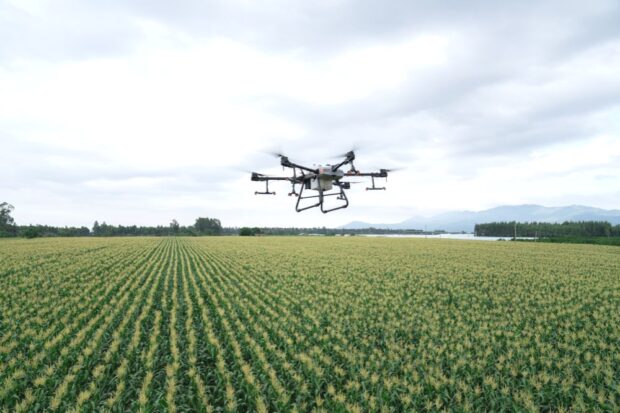Spray drone services provider Rantizo has raised a $6 million expansion of its series A round (adding to the $7.5 million announced in 2020) led by Leaps by Bayer, and supported by Fulcrum Global Capital and Innova Memphis.
The capital injection will help the Iowa-based company expand its nationwide operator network, which now works across 30 states with more than 20% of the nation’s top 50 ag retailers.
We’ve seen demand for the service outstrip supply quite significantly’
Right now, CEO Mariah Scott tells AgFunderNews, drones account for “a tiny fraction” of crop spraying, but that fraction “is growing exponentially.”
“So if you look at ground plus aerial applications, that’s probably around a $10-11 billion market opportunity, and drones are a tiny fraction of that today, but that’s a big market to go after.”
In many cases, says Scott, drones are used to compliment traditional ground spraying systems for difficult-to-reach areas, soggy ground, or areas where greater precision is required than can be delivered by manned aerial spraying vehicles such as planes and helicopters.
“We’ve seen demand for the service outstrip supply quite significantly, and we’ve had exponential growth in the number of acres sprayed year-on-year for the last three years, because what ag retailers and growers are seeing is that the drone is a timely and versatile tool.
“So on the timely front, it’s about being a local service provider, if you have an issue they can get drones out there right away, which isn’t always true with helicopters or crop dusters, which can be harder to schedule.
“As for versatility, if you have acreage with a lot of trees or waterways or buildings or that is awkwardly shaped, the drone is a great tool because you can fly very precisely. You’re also flying much closer to the crop, so you don’t have the problems with drift or overspray. In cases where you’ve had a lot of rain and you can’t get a ground rig in there, or you have a crop that needs to remain irrigated, you don’t have to turn the irrigation off.”
“Rantizo has been a great partner in servicing our grower customers. The drones utilized by Rantizo allow us to provide crop inputs on acres that otherwise may miss an application or go untreated due to poor or wet conditions.” Jordan Hart, regional operations manager, Simplot
Rapid improvements in speed and capacity
While uptake of drones for spraying crops has historically been hampered by high costs and low throughput, speed and payloads are increasing continuously, which will steadily increase their commercial viability, predicts Scott, who joined Rantizo in April from Verizon Robotics.
“We’ve seen dramatic improvements in the tank capacity and now drones are pretty routinely getting 20- 25 acres an hour vs 4-5 acres just a couple of years ago, and I expect that that number is going to continue to increase rapidly. Most of our operators see they break even or go positive in the very first season of spraying.”
She adds:
“I have been in drones for the last 10 years and I have seen how quickly DJI [the drone manufacturer that Rantizo partners with] innovates and how much they drive improvements. But there are also other drone manufacturers that are increasing capacity and increasing the acreage power, so we’re talking to companies such as Guardian Agriculture and there’s another company called XAG that we’ve also tested.
“So most of our operators use DJI but our software or support training is hardware agnostic.”
‘We’re essentially acting as a marketplace’
Scott, who has been at the helm of Rantizo for less than six months, has been driving a new strategy, she explains: “So I joined as part of a shift towards software and services. Previously, the company had been focused on reselling hardware, so reselling DJI drones primarily, together with support and training and insurance to help independent spray drone operators get into the business of doing application services.
“When I joined and brought in a new leadership team, we looked at where the company had strong value and that was in building a nationwide network of spray drone operators. So we have the largest network of spray drone operators, folks to whom we have sold the equipment, the flight operations support, service, repair, insurance, training, everything they need to be licensed, qualified, insured and able to deliver spray drone services.
“And so where we started focusing was how do we connect that supply of qualified operators to demand? We’re essentially acting as a marketplace where we’re connecting the demand and the supply and we take a margin across that marketplace.”
She adds:
“So we see our primary customer as the ag retailer; we’re helping them deliver a service to their grower customers for acres that aren’t treated well today. Most ag retailers today would contract with an aerial application provider; they don’t own helicopters and airplanes. So we’re offering a similar model, but for drone spraying.”
Higher-capacity drones
Looking ahead, she says:
“As the drones increase capacity, spray drones may be more of a direct replacement [for traditional ground spraying or aerial crop dusting] rather than a complimentary opportunity. Especially as they get up towards 50-60 acres an hour, which I would expect in the next year or two.”
Photo: Rantizo
Source: AgFunder News

